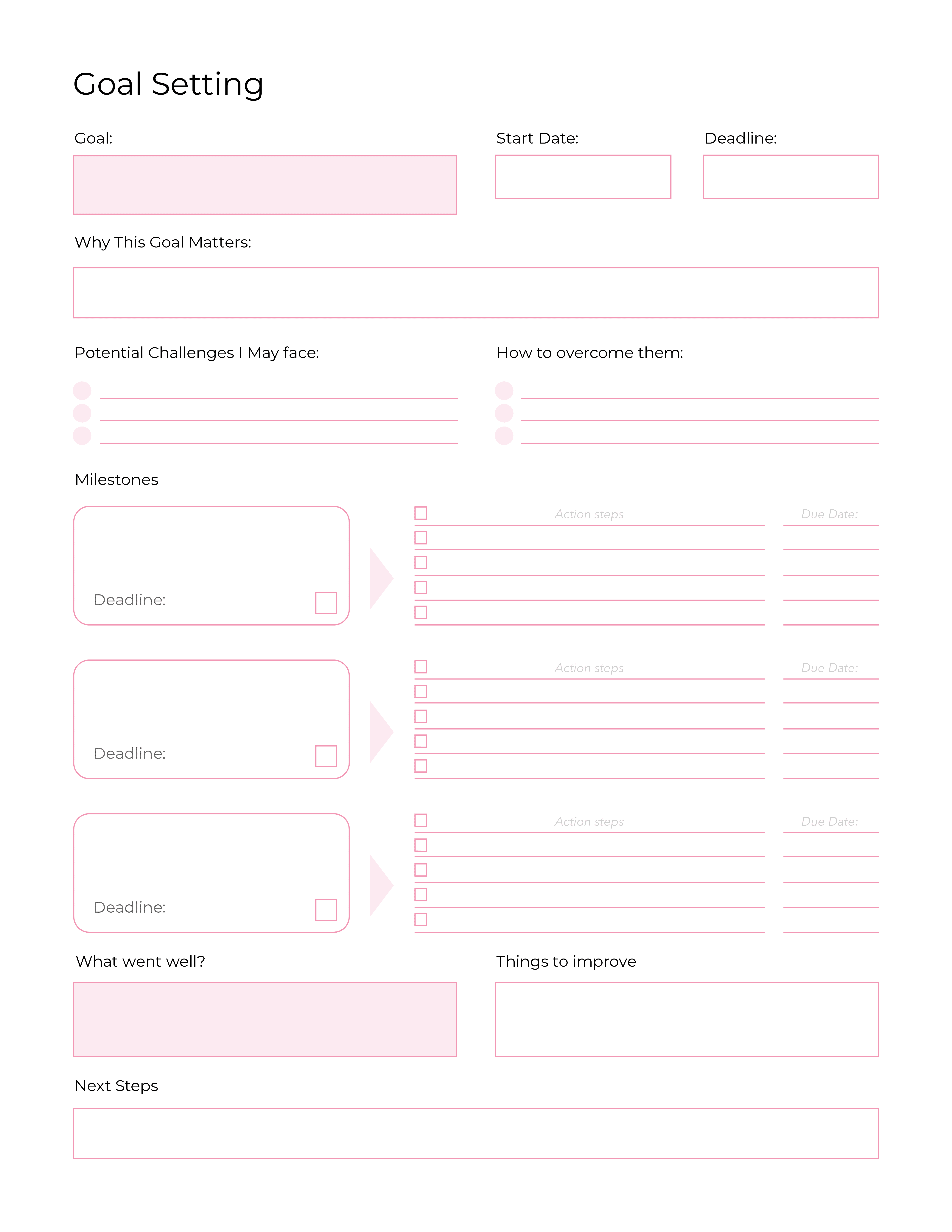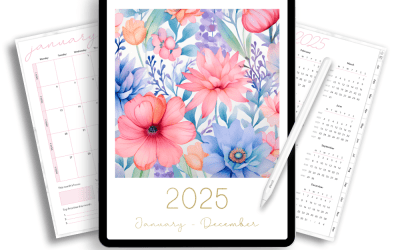Does a new month ![]() new goals? There’s something incredibly refreshing about the start of a new month.
new goals? There’s something incredibly refreshing about the start of a new month.
Like when you buy a brand-new notebook, and you get to fill those blank pages with all your plans and dreams. Setting new goals that align with where or who you want to be is important no matter what area of life you want to improve.
What’s the point of start fresh each month? Doesn’t that slow us down?
Well, it’s the perfect opportunity to reflect on what worked and what didn’t, and to set new intentions that align with where it is you want to be. If you shift your mindset to consider each new month as a mini fresh start, you’ll be able to reset, refocus and see a new perspective on your old goals to help you develop new ones. Cool right?
It’s all about making continuous improvements and celebrating small wins along the way.
The aim here is ideally more focus and increased motivation. Arguably one month, 30 days, is just the right amount of time to see real progress in your life without feeling overwhelmed. The idea is to break down those big, (sometimes incredibly) intimidating goals into smaller ones you can actually manage.
If you want to be able to actually set and smash your yearly goals, you can take a lot from this post about setting smaller monthly goals. Let’s dive in…
Let’s Talk All Things Goal-Setting
The only way I know how to truly track your progress and own personal growth is by setting goals.
Clear, concise, and well thought out goals are key to success, and thinking otherwise could be to your disadvantage.
When you set goals, you’re essentially giving your brain a clear target to zero in on. The result is a sharper focus for the goal ahead and amped up motivation in order to achieve what you’ve set out to do.
Now, when you’re regularly setting new monthly goals, it’s not just about having a plan for the short term. Each of these smaller goals acts as a building block, paving the way for bigger goals the pack a bigger punch long term.
Don’t think of it as ticking off items on your to-do list without a long term focus; it’s about continuously evolving and improving your life over time.
One of the key theories behind goal setting is the Goal-Setting Theory by Locke and Latham. What they say is that clear, more challenging goals, along with the right feedback, leads to higher performance and better results.
New Month
New Goals
Goals direct attention and effort toward activities that are relevant and away from those that are not. Meaning your less likely to get distracted.
More importantly, when you’re able to set those goals and achieve them, your personal satisfaction gets a major boost!
That dopamine release you get when you achieve the goals you set (whenever it was) is super satisfying! Yes, that feel-good hormone! Which not only makes you feel accomplished but also motivates you to set and achieve even more goals. Win Win in my book.
There is no lose scenario when you are focused and stick to the plan. Worse case scenario you’ll learn from your experience and best case is a major boost in confidence and a more positive outlook on life overall.
Why Small Monthly Goals Can Be Game Changing
Monthly goals are a perfect sweet spot between those short-term to do’s and long-term visions and can be an incredibly powerful way to get you closer to that ultimate goal. Here’s why:
- It’s time frame is manageable: 30 Days is a good amount of time to make significant progress without feeling overwhelming. You’ll be able to see tangible results within a relatively short period.
- Shorter deadlines are a good thing: With a bit of a squeeze, a time crunch and tighter deadline in sight, people stop messing around and simply get things done. This 30 day time constraint should allow you to just take action on the tasks you were procrastinating on.
- You’ll be reflecting more often: You get quicker feedback on your progress with monthly goals. This immediate response lets you know if you’re on the right track or if you need to adjust your methods. You’ll be able to have regular reflections on your goals and actions over the past month. Giving you more opportunities to pivot and adjust your goals as you need to, keeping them relevant.
- You’re continuously improving: By setting and reviewing goals every month, you create a cycle of continuous improvement. You’ll soon start to notice that every month you’re building on the previous one. Steady progress toward larger, long-term goals is better than erratic bursts of effort that lead to quicker burnout. Build the habits, learn from the process and adjust tactics along the way.
- Major boost in motivation: Many wait for the motivation to take action, not knowing that it’s the action that provides the motivation. The sense of accomplishment you get from achieving monthly goals is an excellent motivator to tackle the next one and then the one after that. Leaving you more likely to stay on track and reach even higher goals.
The goal here with setting monthly goals isn’t to simply achieve more; the aim is to create a structured, focused approach to your own personal growth. When you’re able to reflect, assess and adapt, you learn a lot more through the process.
Now you’re on track to living your best life possible, staying organized and motivated along the way. Let’s focus on how you can do it..
Top Tips for Setting Goals That Work for You
No matter how you swing it, setting goals just feels good! We are here for a good time, not a long time, so it just makes sense to make that time (however long it is) as amazing as possible.
Here’s how you can make sure that each goal you set is not just a shot in the dark but something that you actually achieve..
- Get a Head Start: Instead of waiting for the month to begin, start plotting a few days beforehand. Kick off your goal-setting process in the last few days of the previous month. Not only will you get a running head start but it’ll make sure you’re not scrambling to make plans when the new month rolls in. It’s like giving yourself a warm-up lap before the race begins, setting the pace and getting your mind geared up for the challenges ahead.
- Zero In On What Fires You Up: Before anything else, pinpoint what really lights you up. What gets your butt out of bed in the morning? Connect those goals to your passion, and you’ll find yourself powered by a seemingly endless energy source.
- Reverse Goal Setting: When I set goals I like to start with the end goal in mind. What’s the end of the month looking like for you? Start there and work backwards by setting mini goals to deconstruct that success into achievable steps. When you work this way, it’s almost guaranteed that you’ll reach the end of the month feeling accomplished.
- Micro-Goals for Micro-Days: Break down each day into tiny, almost laughably small goals. This could be as simple as “smile at a stranger” or “write one paragraph”. Doing this will make your to do’s feel like a game and will boost that feeling of achievement.
- Stay Grounded in Reality: Aim high but keep one foot firmly on the ground. Crafting achievable goals means assessing what you can realistically manage within your current limits. Sometimes, the biggest victories come from the smallest, most realistic steps.
- Don’t tell anybody: This goes against a lot of the popular advice of sharing your goals with others in order to hold yourself accountable. Trust me you don’t want to be sharing your goals, especially with people who don’t understand your vision or have never themselves set or achieved any goals. If you do share, share with someone on the same path as you or seek out a mentor who’ll encourage you to reach your goals.
- Goal Visualization: Spend a few minutes each morning visualizing yourself achieving your goals. If you can start to see in your mind now where you want to be future, it’ll give you a big confidence boost. Doing this every morning before all of the crazy sets in, you’ll give your day more of a fighting chance for success.
- Details, Details, Details: Vague goals are like misty mornings; they won’t clear up unless you shine a little light on them. Be as specific as possible with your goals. Swap “I want to get fit” with “I will attend three yoga classes per week”—now that’s a goal you can work with!
- Change it up: Alter something in your workspace or home at the start of each month to signal a fresh start. This could be as simple as rearranging your desk, introducing new scents, or changing your desktop wallpaper.
- Anticipate Roadblocks: Life loves a curveball. Thinking ahead about possible challenges and plotting out how you’ll handle them keeps you two steps ahead of any setbacks.
- Regular Check-Ins: Set a regular review session for your goals. Maybe it’s every Sunday night; take a moment to reflect on your progress, celebrate the wins, and tweak your strategy if certain things aren’t panning out.
- Don’t believe the doubt: Sometimes the fear of failing stops us from creating goals in the first place. If you don’t set goals, then you won’t fail, right? Equally, if you don’t set goals, you likely won’t succeed either. By not setting goals, you’re essentially robbing yourself of the opportunity achieve TRUE potential. This is going to require you stepping out of your comfort zone and facing those fears head-on.
Not only will these tips make you more likely to stick to your action plan, but it also incorporates elements of fun. Be accountable for your goals always.
How to Set and Achieve Your Goals This Month
It’s now time to make this YOUR month for setting and achieving those goals. I like the S.M.A.R.T goal system for defining your goals but I like to take it a step further.
It doesn’t matter if you set goals and didn’t follow through in the past. This is a new start for you and you’ve got to stop thinking otherwise.
My goal setting strategy is sort of like a systematic approach that starts with identifying what you want to achieve and the desire for it, believing in it 100%, foreseeing any obstacles, planning how to get there, intensely visualizing the goals and then executing your plan with daily, weekly, and monthly tasks. Here’s how to get started:
Step 1: Desire
When you’re thinking about your goals, you’ve got to consider “how badly do I want this?”. Make your goals personal to you and set a specific goals that describe the EXACT life you want.
Step 1 is to define what is you want through desire.
It’s not magic, it simply visualizing or desiring something so badly, that every action/step you take from that point onwards aligns with that specific desire.
Questions you may need to ask yourself in order to define clear and relevant goals might be:
- What would you do more or less of if you had all the time in the world?
- What have you always wanted to do but were afraid to try?
- If you had all the money in the world, what is it you would be doing?
- Which activity give you the most joy in your life?
- Start to think about your top 50 goals you want to achieve in your life. Which ones sooner rather than later? Which ones this year? Then this month…
These questions are important because the goal is to enjoy as many of the great moments as possible in your life. So if you are going to set goals, they need to be ones you are highly passionate about.
During this step, make your goals personal and specific enough that they vividly describe the life you want.
Step 2: Belief
You MUST believe in the possibility of achieving your goals. You can set a goal that sees you making 50k by the end of the month, but if you don’t believe it’s possible, it’s almost always destined to fail.
If you’re beginner at setting goals, the last thing you want to do is set a goal that’s nearly impossible in order to stretch yourself. Consider your current situation and adjust your monthly goals accordingly.
True belief means that you walk, talk, think, feel, behave and get results consistent with your beliefs.
Step 3: Write It Down
Take your goals out of your head and put it down on paper, where it has real substance. By writing down your goals, you’re solidifying your intentions and creating a magnet of attraction that starts to draw that thing (whatever it is) into your life.
Start using a journal, digital planner, or app dedicated to goal-setting, to solidify your intentions. Write these goals down to transition them from mere thoughts to actionable intentions. This act of writing not only reaffirms your commitment but starts to pull your desired reality towards you.
If you are stuck figuring out which goal you want to achieve. Take the list and sort them in order of priority. Focus on that the highest priority goal and make it your mission to achieve it.
Step 4: Determine your Reason “Why”
Understanding why your goal is important is enough of a motivation to see you through actually achieving the goal. That means that even through obstacles or challenges that might come up along the way, your ‘why’ will help you push through that barrier.
If you understand your “why”, then the “how” is easy.
Step 5: Set a Deadline
Deadlines create urgency. When you set a realistic deadline for your goal, it’s less about adding extra pressure and more about giving yourself a clear timeframe to work with – thus increasing focus.
Plus, knowing there’s a specific end date helps kick procrastination to the curb, so you’re more likely to take action today instead of putting it off till tomorrow.
Step 6: Anticipate Obstacles
There will always be something that stand in the way of you and your end goal. Figuring out what those potential challenges might be, will make you more prepared well in advance.
What things are likely to stop you in your tracks? What things do you need to have in place before you reach your goal?
This isn’t about fearing what might go wrong; it’s about being so committed to your goals that you’re ready to face and tackle anything that comes your way. So, take a moment, think about what might set you back, and plan ways to overcome these obstacles. It’s called being proactive and’ll keep you two steps ahead.
Step 7: Gather Tools and Resources
If you want to achieve something you haven’t before, you’ll need skills and tools you’ve never had before. Now it’s time to identify all the tools, resources, and skills you’ll need to make this goal a reality.
What’s the one skill you know would help you get to where you want to be? Perhaps you should look at other successful people in that area. What tools did they use? What skills did they learn?
Step 8: Make a Plan
Break down your goals into smaller tasks that are manageable and that you can tackle daily, weekly, and monthly. It needs to be tasks in order of priority. This plan acts as your roadmap, detailing each step you need to take to reach your ultimate objectives.
Always look for the simplest and most direct way to get from where you are to where you wanna go – Brian Tracy
You have to identify the solution that has the fewest amounts of steps and most importantly get started. The Goal + the Plan will solidify the drive to complete them in your mind like cement.
Step 9: Visualize Success
The most powerful thing you can do at this stage is to imagine the goal as if you have already achieved it. Visualization is a powerful practice and has been proven time and time again to your motivation and put you into that positive mindset – which is needed to reach your goals.
Spend time imagining your goals without wondering why you haven’t achieved it. Feel the success, see yourself where you want to be, and let this vision drive you towards action every single day.
Step 10: Become Unstoppable
Finally, you’ve got to adopt a mindset that refuses to quit. Continuous effort without giving up increases your resilience and capability to succeed. Every time you persist, you’re strengthening your persistence even more to keep going. This is going to guarantee your success.
Remember, the only true failure is stopping; everything else is just a learning step on the path to success.
“The only way you fail is if you quit.” – Dalai Lama
Important Daily, Weekly, and Monthly Checklist
I want to help you achieve your goals as much as possible so I created a checklist of tasks you should do on a daily, weekly and monthly basis.
These tasks are impactful and practical enough to help you stay on track with your goals. The checkboxes are interactive, so you can check them off on this site each time you complete the task.
Daily Tasks
Weekly Tasks
Monthly Tasks
Staying on Track with Your “New Month New Goals”
Now you’ve set your goals, the aim is to stay on track and actually reach the top of the mountain.
How exactly do you do that now?
Here’s how I manage to stay on track with each of my own goals:
Regular monitor your goals, actions & outcomes
- Track Your Progress: I find using a basic spreadsheet helps me visualize how far I’ve come and what’s left to achieve. I’ll list my main goal, deadline, reason why, rewards, motivation all in their own columns with a checkbox next to each goal. Checkpoints are fun and easy to monitor.
- Daily Check-ins: At the end of each day, I make a note of the tasks I was able to complete and how to do things differently tomorrow. That way I am holding myself accountable and also making it clear how to improve. For me, it keeps the momentum going and makes sure I don’t veer off.
Adjust the Plan
- Be Flexible: Sometimes, what I thought was a smart goal at the beginning of the month might not be that way at the end. It needs tweaking. It’s just as important for you to be adaptable as it is for you to be driven.
- Monthly Reviews: When you reach the end of the month, take a deeper look at your progress. Did you meet your goals? What worked, and what didn’t? The result of that should be more achievable and improved goals for the next month.
Keeping the Motivation Going
- Celebrate Small Wins: It doesn’t matter how small the win, celebrate it. Even though you haven’t reached your destination, this small gesture (towards yourself) is often more than enough to keep you going.
- Visual Reminders: Personally I like to keep my goals on a physical vision board and on a piece of paper in my wallet when I’m out. Seeing them every day keeps them alive in my mind and reminds me of what I’m working so hard for.
Staying Focused
- Minimize Distractions: Do not disturb for me is a frequent flyer. If I don’t turn it on and switch off , there will no doubt be an endless amount of things stopping me from staying focused. My focus is sharp when I eliminate any distractions.
- Prioritize Tasks: I always tackle the most important tasks first. This not only ensures that the crucial things get done but also helps in managing the day’s energy levels effectively.
Things That Help Me: Monthly Goal-Setting Essentials
It’s important to have the right tools with you when your working on your new monthly goals. Here are some resources and tools that have personally helped me stay on track with my “new month new goals” routine:
Dedicated Goal Worksheet
Using the goal setting pages in my 2024 planner has been essential for setting and tracking my monthly goals. You should be looking for planners that have a dedicated goal-setting section with areas for reflection and adjustment, plus perhaps a monthly overview where you’re able to plan your tasks over the next month. Whatever you use, it should keep your objectives clear and focused.
Click here or on the form below to fill out your goals now:
Goal-Tracking Apps
Apps like Strides or ClickUp have features that allow you to set monthly goals, track your daily progress, and review your performance at the end of each month. These apps are great for keeping all your monthly targets in one place and can give you a motivational boost with reminders and rewards for achieving your goals.
Strides provides customizable goal and habit templates, visual progress tracking with charts and graphs, and syncs across iOS.
ClickUp integrates goal-setting with task management and time tracking, offering visual progress tracking with Gantt charts and Kanban boards, and syncs across web, mobile, and desktop.
Digital Calendars
If you blocking out time on a calendar, using your Google or Apple Calendar might be a better fit for you. Colour code each task and use time blocks to set aside specific times each day and week to work towards your monthly goal.
Wrapping Up
As we wrap things up, it’s clear that breaking down your ambitions into manageable monthly goals is a game-changer. By setting clear, actionable goals every month, you create a cycle of growth and achievement that keeps you motivated and on track.
Start with a strong desire and a belief in your ability to succeed. Crafting specific, measurable, and realistic goals is your foundation. With the right tools and resources at your disposal, and a solid plan that includes daily, weekly, and monthly tasks, you’re well on your way to transforming your life.
Stay flexible, anticipate obstacles, and celebrate your victories—big or small. Keep a positive mindset and leverage the support of your community to stay motivated.
So, here’s to making each new month an opportunity for growth, learning, and success. Embrace the power of monthly goal-setting and turn your dreams into reality, one step at a time. Ready to transform your life? Your next month of achievements starts now!









